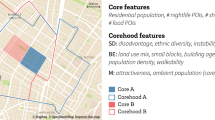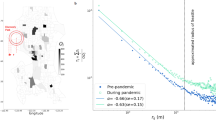Abstract
Many studies have revealed the predictive power of the most frequent, regular and habitual mobility patterns. However, it remains unclear which components of the mobility patterns contain the most informative signals for predicting disparate economic development across urban areas. Here we use machine learning to predict economic outcomes by analyzing the heterogeneous mobility networks of 687 activities from more than 560,000 anonymized users in Boston, Chicago and Miami. We find that mobility patterns are highly predictive of the current and future economic development in major American cities but, surprisingly, the high predictive power is concentrated on infrequent, irregular and exploratory activities. These predictive activities account for only less than 2% of total visits but successfully explain more than 50% of variation in economic outcomes. Future research should shift more attention from regular visits to irregular activities, and policymakers could leverage these infrequent yet informative activities to manage urban economic development.
This is a preview of subscription content, access via your institution
Access options
Subscribe to this journal
Receive 12 digital issues and online access to articles
$119.00 per year
only $9.92 per issue
Buy this article
- Purchase on Springer Link
- Instant access to full article PDF
Prices may be subject to local taxes which are calculated during checkout




Similar content being viewed by others
Data availability
The data that support the findings of this study are available from Cuebiq through their Data for Good program, but restrictions apply to the availability of these data, which were used under the licence for the current study and are therefore not publicly available. Information on how to request access to the data, and its conditions and limitations, can be found at https://www.cuebiq.com/about/data-for-good/. The locations and activity categories of visits were obtained via Foursquare using their Public Search API. The public data source of this study (for example, ACS) is available in the Github repository at https://github.com/cjsyzwsh/economic_growth_usa.git.
Code availability
The analysis was conducted using Python. The scripts that support the findings of this study are also available via the Github repository at https://github.com/cjsyzwsh/economic_growth_usa.git.
References
Aiken, E., Bellue, S., Karlan, D., Udry, C. & Blumenstock, J. E. Machine learning and phone data can improve targeting of humanitarian aid. Nature 603, 864–870 (2022).
Smythe, I. S. & Blumenstock, J. E. Geographic microtargeting of social assistance with high-resolution poverty maps. Proc. Natl Acad. Sci. USA 119, e2120025119 (2022).
Chi, G., Fang, H., Chatterjee, S. & Blumenstock, J. E. Microestimates of wealth for all low-and middle-income countries. Proc. Natl Acad. Sci. USA 119, e2113658119 (2022).
Bettencourt, L. M. A., Lobo, J., Helbing, D., Kuhnert, C. & West, G. B. Growth, innovation, scaling, and the pace of life in cities. Proc. Natl Acad. Sci. USA 104, 7301–7306 (2007).
Simini, F., Gonzalez, M. C., Maritan, A. & Barabasi, A.-L. A universal model for mobility and migration patterns. Nature 484, 96–100 (2012).
Schlapfer, M. et al. The universal visitation law of human mobility. Nature 593, 522–527 (2021).
Alessandretti, L., Aslak, U. & Lehmann, S. The scales of human mobility. Nature 587, 402–407 (2020).
Gonzalez, M. C., Hidalgo, C. A. & Barabasi, A.-L. Understanding individual human mobility patterns. Nature 453, 779–782 (2008).
Bettencourt, L. M. A., Lobo, J., Strumsky, D. & West, G. B. Urban scaling and its deviations: revealing the structure of wealth, innovation and crime across cities. PLoS ONE 5, e13541 (2010).
Song, C., Koren, T., Wang, P. & Barabasi, A.-L. Modelling the scaling properties of human mobility. Nat. Phys. 6, 818–823 (2010).
Pappalardo, L. et al. Returners and explorers dichotomy in human mobility. Nat. Commun. 6, 8166 (2015).
Chetty, R., Friedman, J. N., Hendren, N., Jones, M. R. & Porter, S. R. The Opportunity Atlas: Mapping The Childhood Roots of Social Mobility (National Bureau of Economic Research, 2018).
Bell, A., Chetty, R., Jaravel, X., Petkova, N. & Van Reenen, J. Who becomes an inventor in America? The importance of exposure to innovation. Q. J. Econ. 134, 647–713 (2019).
Granovetter, M. S. The strength of weak ties. Am. J. Sociol. 78, 1360–1380 (1973).
Granovetter, M. The impact of social structure on economic outcomes. J. Econ. Perspect. 19, 33–50 (2005).
Hidalgo, C. A. & Hausmann, R. The building blocks of economic complexity. Proc. Natl Acad. Sci. USA 106, 10570–10575 (2009).
Eagle, N., Macy, M. & Claxton, R. Network diversity and economic development. Science 328, 1029–1031 (2010).
Gomez-Lievano, A., Patterson-Lomba, O. & Hausmann, R. Explaining the prevalence, scaling and variance of urban phenomena. Nat. Human Behav. 1, 0012 (2016).
Bettencourt, L. M. A., Samaniego, H. & Youn, H. Professional diversity and the productivity of cities. Sci. Rep. 4, 5393 (2014).
Chong, S. K. et al. Economic outcomes predicted by diversity in cities. EPJ Data Sci. 9, 17 (2020).
Pentland, A. Diversity of idea flows and economic growth. J. Social Comput. 1, 71–81 (2020).
Llorente, A., Garcia-Herranz, M., Cebrian, M. & Moro, E. Social Media Fingerprints of Unemployment. PLoS ONE 10, e0128692 (2015).
Su, J., Kamath, K., Sharma, A., Ugander, J. & Goel, S. An experimental study of structural diversity in social networks. In Proc. International AAAI Conference on Web and Social Media Vol. 14, 661–670 (AAAI, 2020).
Gee, L. K., Jones, J. J., Fariss, C. J., Burke, M. & Fowler, J. H. The paradox of weak ties in 55 countries. J. Econ. Behav. Organization 133, 362–372 (2017).
Jahani, E., Fraiberger, S., Bailey, M. & Eckles, D. Long ties, disruptive life events, and economic prosperity. Proc. Natl Acad. Sci. USA 120, e2211062120 (2022).
Centola, D. & Macy, M. Complex contagions and the weakness of long ties. Am. J. Sociol. 113, 702–734 (2007).
Jiang, S., Ferreira, J. & Gonzalez, M. C. Clustering daily patterns of human activities in the city. Data Min. Knowl. Discov. 25, 478–510 (2012).
Jiang, S., Ferreira, J. & Gonzalez, M. C. Activity-based human mobility patterns inferred from mobile phone data: a case study of singapore. IEEE Trans. Big Data 3, 208–219 (2017).
Hunter, R. F. et al. Effect of COVID-19 response policies on walking behavior in us cities. Nat. Commun. 12, 3652 (2021).
Yang, Y., Pentland, A. & Moro, E. Identifying latent activity behaviors and lifestyles using mobility data to describe urban dynamics. EPJ Data Sci. 12, 15 (2023).
Solow, R. M. A contribution to the theory of economic growth. Q J. Econ. 70, 65–94 (1956).
Barro, R. J. Economic growth in a cross section of countries. Q. J. Econ. 106, 407–443 (1991).
Glaeser, E. L., Scheinkman, J. A. & Shleifer, A. Economic growth in a cross-section of cities. J. Monetary Econ. 36, 117–143 (1995).
Moro, E., Calacci, D., Dong, X. & Pentland, A. Mobility patterns are associated with experienced income segregation in large us cities. Nat. Commun. 12, 4633 (2021).
Dong, X. et al. Social bridges in urban purchase behavior. ACM Trans. Intell. Syst. Techno. 9, 1–29 (2017).
Singh, V. K., Bozkaya, B. & Pentland, A. Money walks: implicit mobility behavior and financial well-being. PLoS ONE 10, e0136628 (2015).
Blumenstock, J., Cadamuro, G. & On, R. Predicting poverty and wealth from mobile phone metadata. Science 350, 1073–1076 (2015).
Barbosa, H. et al. Uncovering the socioeconomic facets of human mobility. Sci. Rep. 11, 1–13 (2021).
Aleta, A. et al. Quantifying the importance and location of SARS-CoV-2 transmission events in large metropolitan areas. Proc. Natl Acad. Sci. USA 119, e2112182119 (2022).
Tibshirani, R. Regression shrinkage and selection via the lasso. J. R. Stat. Soc. B 58, 267–288 (1996).
Kreindler, G. E. & Miyauchi, Y. Measuring commuting and economic activity inside cities with cell phone records. Rev. Econ. Stat. 105, 899–909 (2019).
Deaton, A. & Muellbauer, J. Economics and Consumer Behavior (Cambridge Univ. Press, 1980).
Belloni, A., Chernozhukov, V. & Hansen, C. Inference on treatment effects after selection among high-dimensional controls. Rev. Econ. Studies 81, 608–650 (2014).
Luptakova, I. D., Simon, M. & Pospichal, J. Weak ties and how to find them. In 23rd International Conference on Soft Computing 16–26 (Springer, 2019).
Bilbao-Osorio, B. & Rodriguez-Pose, A. From R&D to innovation and economic growth in the EU. Growth and Change 35, 434–455 (2004).
Blumenstock, J. E. Estimating economic characteristics with phone data. In AEA papers and Proceedings Vol. 108, 72–76 (AEA, 2018).
2015–2019 American Community Survey 5-Year Estimates (United States Census Bureau, 2019); https://www.census.gov/programs-surveys/acs
Acknowledgements
We thank Cuebiq, who kindly provided us with the mobility dataset for this research through their Data for Good program. S.W. acknowledges partial support from a University of Florida ROSF-2023 grant. G.W. is partially supported by the NSF (grant no. 1952096). E.M. acknowledges support by Ministerio de Ciencia e Innovación/Agencia Española de Investigación (MCIN/AEI/10.13039/501100011033) through grant no. PID2019-106811GB-C32, and the NSF under grant no. 2218748.
Author information
Authors and Affiliations
Contributions
S.W., G.W., T.Y., E.M. and A.S.P. conceptualized the work. S.W. and Y.Z. performed the methodology, and designed and implemented the experiments. S.W. wrote the original draft, which was reviewed and edited by S.W., Y.Z., G.W. and T.Y. S.W., E.M. and Y.Z. curated the data, which were visualized by S.W. and Y.Z. S.W. and A.S.P. supervised and administered the project.
Corresponding authors
Ethics declarations
Competing interests
The authors declare no competing interests.
Peer review
Peer review information
Nature Cities thanks Yang Yue and the other, anonymous, reviewer(s) for their contribution to the peer review of this work.
Additional information
Publisher’s note Springer Nature remains neutral with regard to jurisdictional claims in published maps and institutional affiliations.
Supplementary information
Supplementary Information
Supplementary Discussion, Figs. 1–6 and Tables 1–13.
Rights and permissions
Springer Nature or its licensor (e.g. a society or other partner) holds exclusive rights to this article under a publishing agreement with the author(s) or other rightsholder(s); author self-archiving of the accepted manuscript version of this article is solely governed by the terms of such publishing agreement and applicable law.
About this article
Cite this article
Wang, S., Zheng, Y., Wang, G. et al. Infrequent activities predict economic outcomes in major American cities. Nat Cities 1, 305–314 (2024). https://doi.org/10.1038/s44284-024-00051-7
Received:
Accepted:
Published:
Issue Date:
DOI: https://doi.org/10.1038/s44284-024-00051-7
This article is cited by
-
Predictive infrequent activities
Nature Cities (2024)



